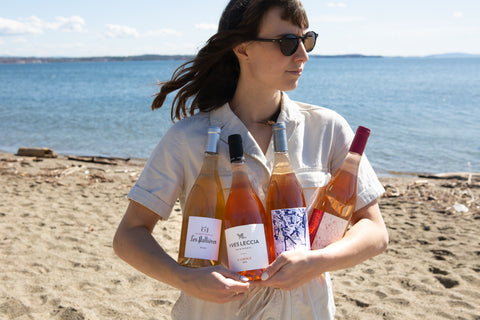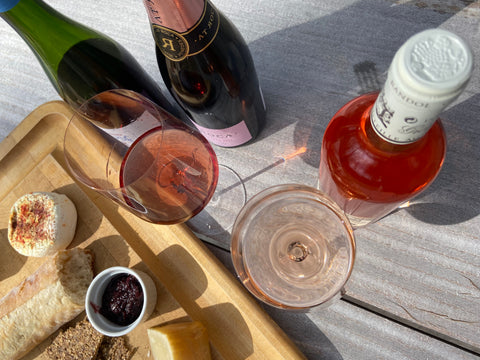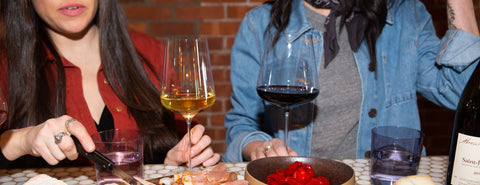It’s easy to get lost in the sea of rosé out there, but we can help you find your footing. This guide will help you learn why you should be drinking more pink wine, which regions to look out for, a few big names you’ll find at Dedalus Wine, and why finding a trusted wine shop is the best way to discover great wine.
Our Take on Rosé
Done right, rosé can be serious or playful, complex or gulpable. It can express terroir and tell a unique story about where it comes from.
As a category, rosé is sometimes looked down on. It isn’t taken as seriously as white and red wines. Many people think rosé is sweet or overly fruity or seasonal — something they can only drink during the summer. But at Dedalus, we get excited about rosés made according to regional traditions that convey terroir. Rosé wines can just as strongly represent a sense of place as red and white wines.”
We’re here to make a case for the full gamut of seriously delicious rosé, and give you the information you need to shop for it.

Why Drink More Rosé
Rosé can come from any winemaking region, any red grape variety, and can be made with any of the three major rosé winemaking techniques: maceration, saignée, and blending. But one thing is true across cuvées: rosé is invariably a great food wine. It’s usually fresh, with juicy palate-cleansing acidity that makes it a powerful karate-chop through rich foods, or a crisp and refreshing pairing with lighter fare like grilled seafood and summer salads.
When it comes to building a meal, or just a cheeseboard, rosé is one of the most dependable wines to have on deck.

Seek Out Exemplary Regions
When you’re looking for rosé, it helps to know a bit about where your wine is coming from. Here are a few of the most important ones to look out for.
Provence
On the Mediterranean coast of France, Provence produces some of the best rosés in the world. It’s home to the inimitable Bandol appellation, the less expensive but completely delicious Cassis AOC, and the largest of all the appellations: Côtes de Provence. You’ll find delicious, lightly colored rosés with notes of lush strawberry, melon, celery, roses, and melon. Look for bottles labeled: Bandol, Cassis, and Côtes de Provence to start.
Bandol
It’s a part of Provence, but deserves its own spotlight. The Bandol appellation is home to some of the best wines in the region. They produce incredible rosé made from Mourvedre, Grenache, and Cinsault, but you’ll also find delicious whites and reds here. Bottles from this region will be clearly labeled as “Bandol.”
Corsica
Corsica makes distinctive rosés that paint an evocative picture of the idyllic, mountainous island with its garrigue strewn coastline, jungly interior, and pristine beaches. They’ve been making pink wines long before the rosé boom of recent years, and primarily use two indigenous grape varieties: Nieullucciu and Sciaccarellu. For a great Corsican rosé, look for bottles labeled with the sub-regions: Patrimonio, Ajaccio, Vin de Corse, and Île de Beauté, to start.
Champagne
Rosé Champagne is seriously good bubbly with a pink twist. It’s usually made by adding a small amount of Pinot Noir or Pinot Meunier to Chardonnay for a light blush colored wine. At Dedalus, we champion grower Champagne estates that do everything in house and make exceptional bubbly at almost half the price of their big brand counterparts. When looking for a great rosé Champagne, look for the words “Champagne Rosé” on the label.
California
California makes incredible rosés with a wide variety of grapes. Our favorites come from smaller vineyards and negociant projects who search out interesting, expressive sites and craft minimal intervention rosé that radiates pure California sunshine — a feeling of eternal summer. If you want to taste terroir driven California rosé, look out for pink wines labeled with specific vineyards or California subregions, like “Santa Maria Valley,” or “Santa Barbara Mountains.”
Tuscany
Here, rosé is known as rosato. It’s usually a slightly darker pink, with more texture and depth than coastal rosés. Tuscan rosato made from Sangiovese has a body, fullness, and acidity that makes it an incredible pairing for rich, tomato-based Italian foods, whether that’s a rustic pizza with melty globs of fresh mozzarella or a decadent bolognese. Look out for the word “rosato” on the label, and a deeper pink color.
Who to Look Out For
-
Tempier, Bandol
-
Clos Sainte Magdeleine, Provence
-
Yves Leccia, Corsica
-
Abbatucci, Corsica
-
Marquiliani, Corsica
-
Presqu’ile, California
-
Sesti, Tuscany
Know Your Local Wine Shop
At the end of the day, the best way to find great rosé is through your favorite local wine shop. At Dedalus, we hand pick every bottle on our shelves. When you come into our shops, or buy online, you’ll find bottles that have been vetted not just for great taste, but for great origins. Our bottles come from real people working hard every day to farm sustainably and make minimal intervention wines that tell a great story.




